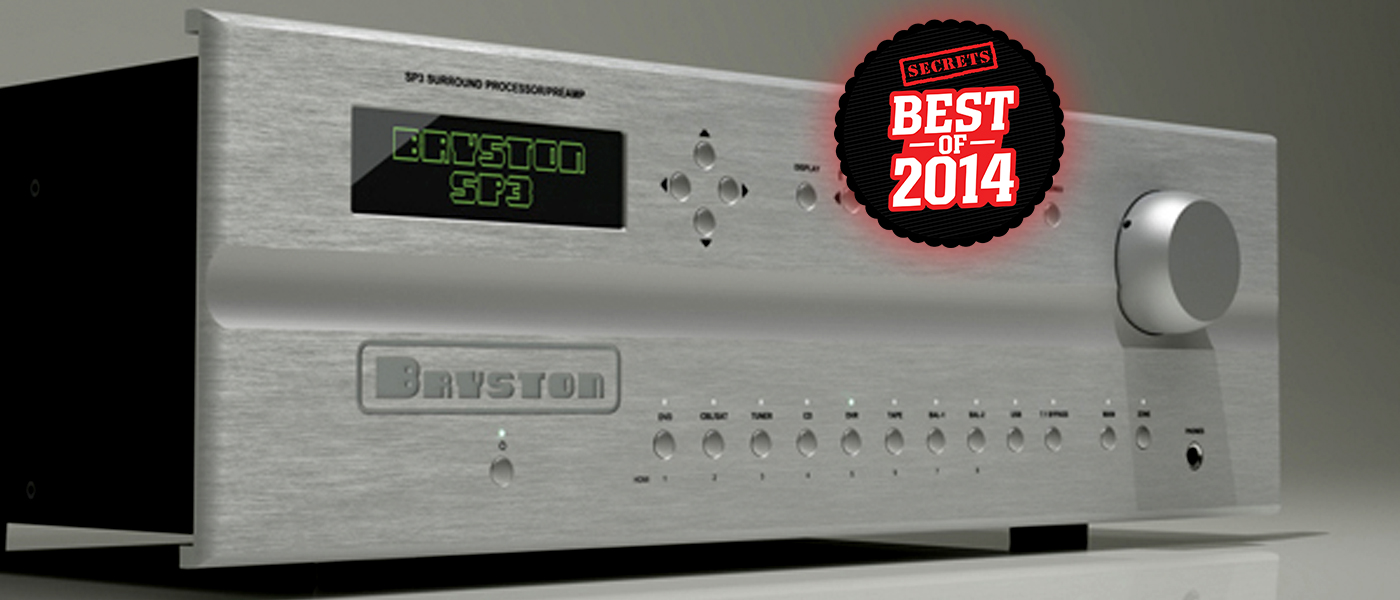
Introduction to the Yamaha CX-A5000 SSP
Suddenly the ESS SABRE DAC is showing up everywhere. At first it was only in high-end audio products like the Oppo BDP-95 and BDP-105 Blu-ray players. Now we have seen it in the Pioneer SC-79 receiver and in a pair of SSPs (Surround Sound Processors): The Krell Foundation and the Yamaha CX-A5000. From bench test numbers to listening tests, the SABRE offers up performance that is at the top of the DAC chain. Many of us just assumed we wouldn’t see it in a processor or receiver due to the price.
YAMAHA CX-A5000 11.1 SSP (SURROUND SOUND PROCESSOR) SPECIFICATIONS
- Video Connections: HDMI 1.4a (7 Rear In, 1 Front In, 2 Out), Component (4 In, 1 Out), Composite (5 In, 2 Out), S-Video (4 In, 1 Out)
- Audio Connections: RCA Stereo (9 In, 1 Out), XLR (1 In), Optical (4 In, 1 Out), Coaxial Digital (3 In, 1 Out), Multi-channel (7.1 In, 11.1 Unbalanced Pre-out, 11.0 Balanced Pre-out), USB (1 Front)
- Other Connections: Ethernet (Internet Radio, DLNA, Streaming and Firmware), 12V triggers (2), RS-232, IR (2 In, 2 Out), 2nd Zone (HDMI, Composite Video, Component Video, Stereo Audio), 3rd Zone (HDMI, Composite, Component, Stereo Audio), 4th Zone (HDMI, Composite, Component), Headphone Jack (6.3 mm), AirPlay
- Dimensions: 7.5″ H x 17.1″ W x 17.6″ D
- Weight: 30 Pounds
- MSRP: $3,000 USD
- Yamaha
- SECRETS Tags: Yamaha, SSPs, Surround Sound Processors, Audio, 11.1
The Yamaha CX-A5000 SSP uses a pair of ESS SABRE 9016 DACs to support its 11 channels. A step down from the 9018, the SABRE should provide the Yamaha with superior jitter reduction, less tonal noise floor, and slightly greater dynamic range compared to the other DACs at its price. Is the rest of the CX-A5000 engineered around the SABRE up to the task?
Design and Seup of the Yamaha CX-A5000 11.1 SSP (Surround Sound Processor)
The Yamaha CX-A5000 is a large beast for a preamplifier. Large in stature and heavy to boot, it certainly feels like a top-end component. Thankfully Yamaha has decided to keep the CX-A5000 as clean as possible on the front panel. There is only a pair of knobs, input and volume, as well as Power and Pure Direct buttons available. More controls are hidden away behind a door on the front panel. The front LED screen is large and easy to read from a distance unlike the tiny letters many companies choose to use.
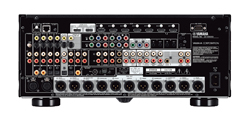
The rear panel is not nearly as simple as the front of the unit. With 11 channels of output available in both RCA and XLR outputs. Curiously the subwoofer output is only available as an RCA output despite subwoofers usually having much longer cable runs. There is your full array of HDMI inputs with dual outputs, a multichannel analog input and a stereo XLR input. Unlike many new products there is a full array of legacy S-Video and Component video inputs for you to use.
The main items missing are built-in Wi-Fi and Bluetooth. There is Airplay for those using Apple products but Bluetooth is far more prevalent. I’m unsure how many people hardwire their preamp instead of using Wi-Fi but including the optional adapter would be nice at this price point.
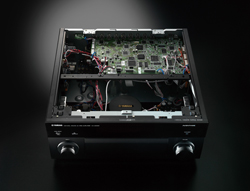
Setup of the CX-A5000 is simple, including the YPAO room correction. In a first for me, there is a 3-point attachment for the microphone when you do your measurements. Using this device the CX-A5000 can calculate the angle of the speakers to the listener, and the reflections, and adjust the output to account for this. It offers the choice of measuring a single listening position, multiple positions, and if you want these angle measurements made. The measurement process is very fast and takes less than 15 minutes.

The measurements are also very accurate. From levels to distances and crossover points, the CX-A5000 was spot-on when I used YPAO. I swapped in different pairs of speakers, added and removed a subwoofer, and made position changes and it never skipped a beat. With how often these systems get this wrong I am always surprised to see this.
The Yamaha CX-A5000 11.1 SSP (Surround Sound Processor) In Use
Since its release the SACD version of Wish You Were Here has been one of my reference recordings. The difference through the CX-A5000 is immediately obvious. There is a level of detail and clarity that I had not heard before. The opening guitar chords of the titular track hung in the air with more clarity and a darker background than before. There is no slight different from my Marantz AV7005 but a massive one that took me by surprise.
Feeding the CX-A5000 more digital sources continued to reveal more detail. Using the integrated Ethernet and iOS software I can easily stream my favorite audio tracks from my NAS. “So What” from Kind of Blue reveals a saxophone with more air and detail around it than before. The pinpoint locations of Beck and his band on Sea Change are easy to determine. The DSD release of Take Five offers spaciousness and details well beyond my prior CD copies of it through the Yamaha.
What doesn’t seem to affect the sound quality much is the room correction on the CX-A5000. Switching between Stereo and Pure Direct modes, the latter of which offers no room correction, present almost no difference in sound quality. Very small differences are there but only after extensive comparison. Most room correction systems offer up far more aggressive changes to my listening room than the CX-A5000 does. The small difference I hear surprises me, but I also do not hear the usual flaws in imaging and detail that I do with it enabled. I prefer the light-touch approach to being too heavy-handed here.
With Blu-ray sources the CX-A5000 continues to excel. The aggressive surround mix in Man of Steel comes across loud and clear. While Superman and Zod level Manhattan to the ground you hear the impact of the buildings all around you. Dialogue is very clear despite everything going on around you and the pans across speakers are seamless.
Switching between analog and digital in Pure Direct using the Oppo BDP-105 as a source, I find virtually no difference. The Blu-ray Audio of Beck’s Sea Change sounds wonderful through both inputs. Through HDMI I might have a bit more detail in the decay of instruments while the RCA inputs shows a little tighter bass. The differences are so small that I’m just as likely imagining these differences as I am hearing them.
Yamaha has also improved the usability of their products since I last used one. The on-screen menus and iOS app are easy to use and provide all the information you need. The one improvement I would like to see on higher-end processors is using RF or Wi-Fi for the remote. A good number of people are going to use universal remotes with their system but for those that do not it makes control much easier. I also prefer just using a remote for volume changes to using an iOS app if I have the unit hidden away.
The Yamaha CX-A5000 11.1 SSP (Surround Sound Processor) On the Bench
First I take a look at the changes offered by the YPAO room correction. For each channel it seems to offer 7 bands of EQ with frequency, adjustment, and Q. Compared to other room correction systems this is a much smaller number of adjustments than they can offer.
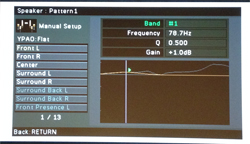
Testing with my speakers, Definitive Technology Mythos STS towers, running full range I see the adjustments that it is making are minor in size. The lowest frequency being adjusted is 78.7 Hz which means most bass issues are not being addressed. It also touches on the response at 16 kHz that is both unnecessary and possibly impossible to hear. Many room correction systems start to roll-off their adjustments past 500 Hz, or at least 5 kHz, as they aren’t really making a noticeable change. The table below shows the adjustments made to my left speaker by YPAO.
| Band | 1 | 2 | 3 | 4 | 5 | 6 | 7 |
|---|---|---|---|---|---|---|---|
| Frequency | 78.7 Hz | 250 Hz | 500 Hz | 1 kHz | 8 kHz | 8 kHz | 16 kHz |
| Q | 0.500 | 1.587 | 1.587 | 0.500 | 0.500 | 1.587 | 0.630 |
| Gain | +1.0 dB | +1.0 dB | -1.0 dB | +1.0 dB | +1.5 dB | +1.0 dB | +3.0 dB |
As the STS are bringing run full-range with no subwoofer I would expect a larger adjustment below 80 Hz but YPAO seems to not correct the bass on the main channels. Looking at this data it is easy to see why I did not hear a large difference with YPAO engaged. The changes it makes are small in nature and not in the bass frequencies that would benefit most.
I also ran the CX-A5000 through the Audio Precision APx 585 and APx 582 test instruments. Use of these was generously provided by Audio Precision and allows us to really investigate how well the ESS SABRE performs and determine what other design decisions might be holding back its performance. This unit uses the same low cost AVR LSI chip used throughout the Yamaha multichannel line, the Renesas R2A15220FP. For more detail I highly recommend looking at the article that Dr. David Rich put together on SSP and receiver design.
To avoid graph overload, I will summarize some of the general measurements first. Tested over HDMI, THD+N on a 0 dBFS 1 kHz signal at unity gain measures at 0.0045%. The volume control was set for an output of 2 VRMS at 0 dBFS. The THD component for that measurement is 0.0042%. Both of these are filtered to only include 20 Hz to 20 kHz data. Signal to Noise Ratio, also filtered, checks in at 111 dB while Crosstalk measures -75 dB at 20 kHz and -100 dB at 1 kHz. The power supply noise spurs are below -110 dB as well.
Moving onto the HDMI graphs, with THD+N vs. Frequency at 2 VRMS we see that it remains below 0.005% up to 5 kHz. There we see a slight rise out to 20 kHz where THD+N approaches 0.008%.
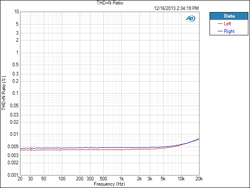
THD+N vs Level with a 1 kHz signal shows that the level falls until 1 VRMS, at which point it begins to rise again. Measurements here start at 5 µVRMS and so that data is dominated by noise.
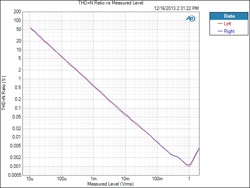
The 1 kHz FFT shows a 2 VRMS signal and a 2nd harmonic that comes in at -92 dBV relative to it. The even-order harmonics are more prevalent than the odd-order ones.
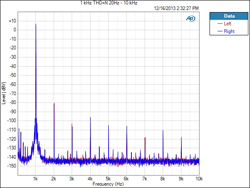
Our 19 kHz + 20 kHz IMD test shows a B-A peak that is over -110 dB below the fundamental frequencies. Sidebands are also below this level with out-of-band 2nd order harmonics close to -100dB below the fundamental tones.
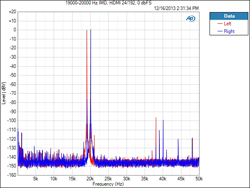
Testing the linearity of the DAC, it is good down to -100 dBFS, at which point an error term becomes visible. By -112 dBFS it is 3 dB off the baseline value. The SABRE DAC is capable of better performance and it is likely the analog section which is introducing the noise here.
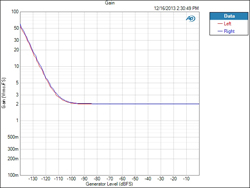
Looking at the time domain data for a -90 dBFS, 1 kHz, 16-bit undithered sine wave we see good, fast response and well-defined 1-bit levels. For comparison, I performed the same test on my Marantz AV7005, which uses the AKM AK4358 DAC, and the result is below the Yamaha CX-A5000 result here.
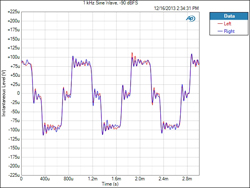

Looking at a -90 dBFS, 24-bit undithered sine wave, we again see very good resolution thanks to the SABRE DAC. For comparison I’ve again included the same test on my Marantz AV7005 to help illustrate the difference.
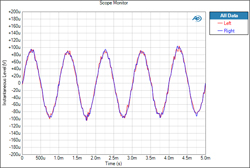
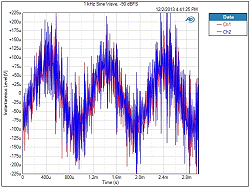
The spectra for a -60 dBFS tone at 1 kHz shows a noise level down below -140 dBV for the FFT bin width used for all graphs in this review.
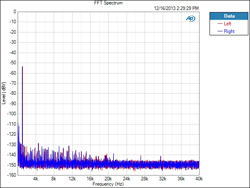
The spectra for the same test done at -90 dBFS also shows a low noise level other than a power supply spur at just below -110 dBV.
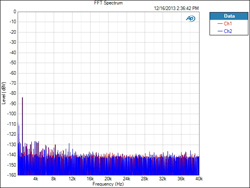
Moving onto analog testing, Dr. Rich examined the service manual to determine how the CX-A5000 is designed. The left and right channels of the multichannel input are wired internally as the two-channel RCA inputs are. They go through the same switch and so have higher distortion associated with them. The other channels on the multichannel input do not pass through this switch and so distortion is lower on them compared to the left and right channels. This is fairly unique to see.
Using Pure Direct mode on an RCA Input, we see 0.0175% THD+N and 0.0174% THD at 2V RMS. We also see an 115dB Signal to Noise Ratio with the same 2V RMS signal.
Using the multi-channel input we see 0.0173% THD+N and 0.0173% THD. This corresponds to the non-multichannel input, just as we expected it to. The Signal-to-Noise ratio checks in at 113dB on the multichannel input as well.
Frequency response is flat from 20 Hz to 40 kHz, and only down by 0.1dB at 100kHz. The power supply noise is below -125dB with spurs visible at 60 Hz and 180 Hz only. Crosstalk measures at -88dB at 1kHz. It is only -120dB at 20Hz and reaches -60dB at 50kHz.
The analog power supply noise and crosstalk results are excellent. The crosstalk shows only capacitive coupling between the channels. Both results reflect careful design of the voltage regulators and PC board wiring one expects in a unit at this price point.
Unfortunately, the THD and SNR performance is similar to products at much lower price points.
THD+N vs Level with a 1 kHz signal over RCA shows that distortion starts to rise at 250 mVRMS, while over HDMI it didn’t rise until 1V. There is a hard knee at 3.2 VRMS as well.

Looking at the same test with a 10 kHz test tone as see almost identical results. THD+N bottoms out at 0.0015% at 300 mV and then rises up until a knee at 3.2 V.
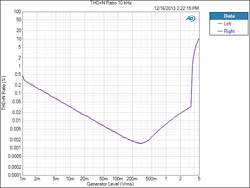
THD+N vs. Frequency over RCA with 2 VRMS in shows a THD+N below 0.02% that extends out to 10 kHz, with a slight rise up to 0.025% by 20 kHz.
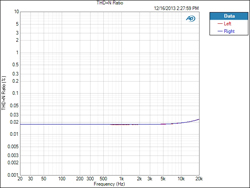
A close look at the spectra from 0 Hz to 1 kHz shows those power supply noise peaks at 60 Hz and 180 Hz. Otherwise the noise floor is very low at -140 dBV.
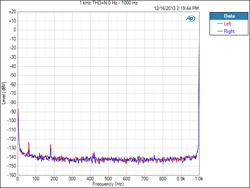
Looking at our same 19 kHz + 20 kHz IMD test over RCA we see much higher sidebands than on the HDMI version, and secondary harmonics that are at -80 dBV instead of -100 dBV.
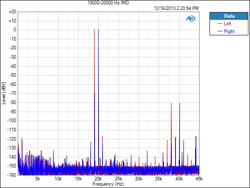
Conclusions about the Yamaha CX-A5000 11.1 SSP (Surround Sound Processor)
When fed digital content, the Yamaha CX-A5000 sounds much better than my Marantz preamp. The differences between the two are not subtle at all, and the use of the ESS SABRE DAC seems to have really paid off in the design. There is more clarity and transparency in every recording that I listened to.
With films the difference is also clear. From effects to dialogue the Yamaha does a fantastic job. Even the smallest sound cues are there and easy to hear through the audio mix. Analog sources sounded up to the level of the digital inputs in my listening, though the bench tests don’t reflect that. Had I compared it directly to a high-end two-channel preamp I might hear a difference with analog but I didn’t in my listening tests.
I find it very easy to recommend the CX-A5000. It is a component that I personally want to keep around to install into my system, as it is a level above what I have. Hopefully more vendors will start using higher quality DACs in their processors as I would like to hear more units that sound this good.


